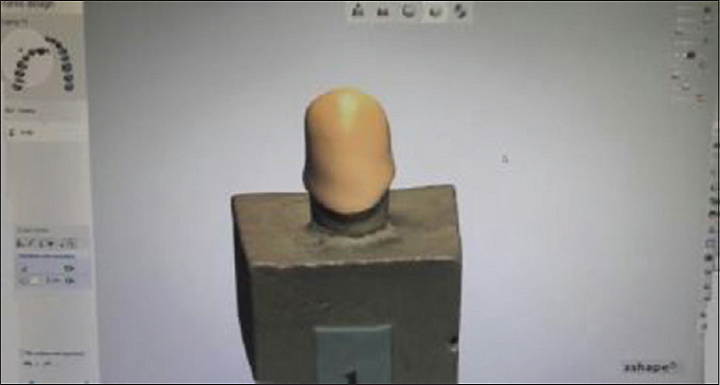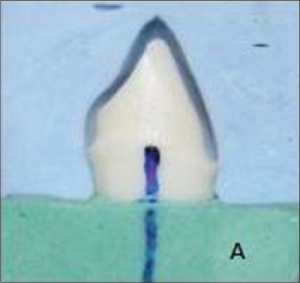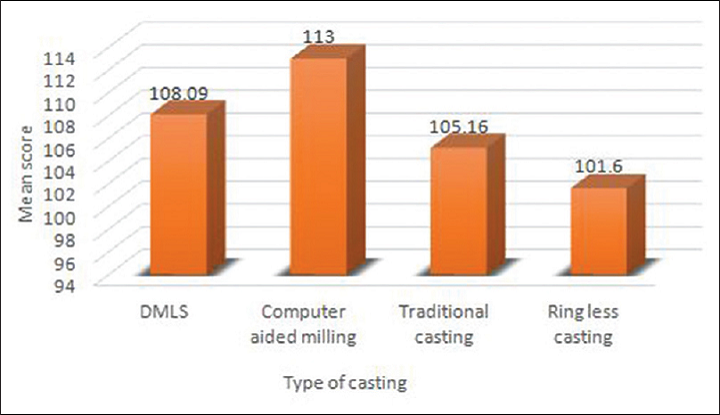Researchers Compare Accuracy of Different Metal Manufacturing Methods, Including 3D Printing, for Dental Copings
 The field of dentistry has witnessed some amazing changes over the last few decades, many of which are thanks to 3D printing. A group of researchers from the Sri Rajiv Gandhi College of Dental Sciences & Hospital in Bangalore, India recently completed a study that used computer-aided milling, ringless casting, traditional casting, and direct metal laser sintering (DMLS) 3D printing to evaluate and analyze the marginal accuracy of cobalt chromium (Co-Cr) copings. A coping, according to the American Dental Association, is a thin covering of the tooth’s coronal (crown) portion, designed to act as a substructure onto which other components can be added to give a prosthesis or restoration its final form.
The field of dentistry has witnessed some amazing changes over the last few decades, many of which are thanks to 3D printing. A group of researchers from the Sri Rajiv Gandhi College of Dental Sciences & Hospital in Bangalore, India recently completed a study that used computer-aided milling, ringless casting, traditional casting, and direct metal laser sintering (DMLS) 3D printing to evaluate and analyze the marginal accuracy of cobalt chromium (Co-Cr) copings. A coping, according to the American Dental Association, is a thin covering of the tooth’s coronal (crown) portion, designed to act as a substructure onto which other components can be added to give a prosthesis or restoration its final form.
The researchers compared the values obtained from each method of fabrication to determine if it could be used to produce a prosthesis that fell within the standards of clinical acceptance. The results of the study were recently published in a paper, titled “Comparative evaluation of marginal accuracy of metal copings fabricated using direct metal laser sintering, computer-aided milling, ringless casting, and traditional casting techniques: An In vitro study.”
“Ten metal copings were fabricated by DMLS, computer-aided milling, traditional casting, and ringless casting. Marginal gap at the buccal, lingual, mesial, and distal areas was measured using silicone replica technique. A digital microscope was used to measure the silicone layer. Statistical analysis was done using one-way ANOVA test and post hoc Bonferroni test to test the difference between the fabrication method and categories of measured points, respectively,” the researchers wrote.
Proper fit is important when it comes to a good, long-term prognosis of a fixed dental prosthesis (FDP). There are multiple ways to create a good FDP, including computer-aided milling, which subtracts prefabricated blanks in order to mechanically process restorations, and DMLS, which uses a laser beam to selectively melt metal powder into the layers that build up the final product.
Casting shrinkage can occur with nonprecious alloys because of the “greater thermal contraction from higher solidification temperature,” so compensation must be achieved for this shrinkage by using investment expansion. But, the rigid steel casting rings used for this can actually restrict the investment’s setting expansion in the radial direction, and their thermal expansion is actually less than what occurs with investment.
“Very few studies have provided a comparative assessment of metal copings based on Co-Cr alloys with regard to their marginal fits,” the researchers wrote. “Therefore, o-Cr alloy coping was fabricated as part of this study using the latest computer-aided milling, DMLS, traditional casting, and ringless casting.”
The team used silicone impression material to make a typodont resin model of a maxillary right canine tooth, and 40 copings were then created for testing. 10 of each were used for the different manufacturing methods, and Group 1 was made up of the 10 DMLS 3D printing copings.
For these, the researchers used a 3D laser scanner from 3Shape to obtain an indirect impression of the tooth model, and then used the data to design the coping in 3Shape’s CAD software program, before they were 3D printed on an EOSINT M 270 3D printer from EOS.
“The design was such that the coping will have a uniform thickness of 0.05 mm, and an allowance of 0.25 was provided 1 mm above the margin as die spacer,” the researchers explained.
In order to measure the marginal gap in the model, all the metal copings were filled with orange light body silicone, to simulate the cement space, and fitted on the tooth model. A contrasting blue light body silicone was used to make it easier to measure the orange layer, and once this second silicone layer had finished its polymerization, the metal copings were separated. A strong, heavy silicone body was also used to cover the copings for stabilization, before they were cut with “a BP blade along the mesiodistal and labiolingual direction.”
The researchers examined the samples under a digital microscope, and also made digital images, which were measured with imaging software. The team measured the thickness, at four points, of the orange light body silicone, which represented its marginal discrepancy.
“The values indicate that the marginal gap was least for the copings fabricated using ringless casting followed by traditional casting and DMLS,” the researchers wrote. “The widest gap was seen in copings fabricated using computer-aided milling. Analysis of results showed statistically significant difference between copings fabricated using computer-aided milling and traditional casting (P = 0.029 and 0.043 – mesial and distal, respectively) and computer-aided milling and ringless casting (P = 0.002 and 0.001 – mesial and distal, respectively).”
While the marginal gap did vary with each fabrication method, all of the marginal gap measurements fit within standard clinical acceptance. The least amount of marginal discrepancy was in the copings fabricated with the ringless casting method, followed by traditional casting, DMLS, and finally computer-aided milling.
“Therefore, the result of this study implies the superiority of conventional casting systems over automated systems, and hence, further improvement of automated systems is warranted,” the researchers concluded.
Co-authors of the study are Annu Eliza James, B Umamaheswari, and CB Shanthana Lakshmi.
Discuss this research and other 3D printing topics at 3DPrintBoard.com or share your thoughts below.
Subscribe to Our Email Newsletter
Stay up-to-date on all the latest news from the 3D printing industry and receive information and offers from third party vendors.
You May Also Like
Gorilla Sports GE’s First 3D Printed Titanium Cast
How do you help a gorilla with a broken arm? Sounds like the start of a bad joke a zookeeper might tell, but it’s an actual dilemma recently faced by...
Nylon 3D Printed Parts Made More Functional with Coatings & Colors
Parts 3D printed from polyamide (PA, Nylon) 12 using powder bed fusion (PBF) are a mainstay in the additive manufacturing (AM) industry. While post-finishing processes have improved the porosity of...
$25M to Back Sintavia’s Largest Expansion of Metal 3D Printing Capacity Since 2019
Sintavia, the digital manufacturing company specializing in mission-critical parts for strategic sectors, announced a $25 million investment to increase its production capacity, the largest expansion to its operations since 2019....
Velo3D Initiates Public Offering in a Bid to Strengthen Financial Foundations and Drive Future Growth
Velo3D (NYSE: VLD) has been among a number of publicly traded 3D printing firms that have attempted to weather the current macroeconomic climate. After posting a challenging financial report for 2023,...



































